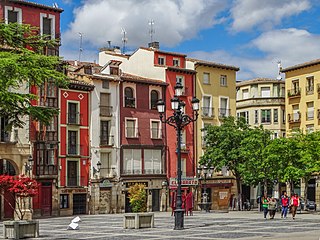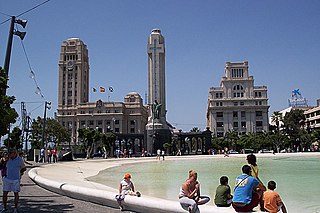 | |
| Location | El Toscal, Santa Cruz de Tenerife, Canary Islands, Spain |
|---|---|
| Coordinates | 28°28′12″N16°14′52″W / 28.4701°N 16.2479°W |
The Plaza de Isabel II is a public square in Santa Cruz de Tenerife, Spain.
 | |
| Location | El Toscal, Santa Cruz de Tenerife, Canary Islands, Spain |
|---|---|
| Coordinates | 28°28′12″N16°14′52″W / 28.4701°N 16.2479°W |
The Plaza de Isabel II is a public square in Santa Cruz de Tenerife, Spain.
The Fuente de Isabel II was constructed in 1844, after several attempts to construct a fountain in El Toscal since the 1820s. [1] It was designed by Pedro Maffiote, and is dedicated to Isabella II of Spain. It is located at the top of Calle de La Marina, between the streets of San Vicente Ferrer and Patricio Estévanez. [2]
It is made from basaltic granite, and has a stepped base, with a water basin. The main part of the fountain has six Tuscan columns, with masks covering the water jets. The top shows the city's coat of arms. [2]
It was one of six fountains operating in Santa Cruz in the 1880s, providing water between 7am and 2pm. [1]

Varadero, also referred to as Playa Azul, is a resort town in the province of Matanzas, Cuba, and one of the largest resort areas in the Caribbean. Varadero Beach is rated one of the world's best beaches in TripAdvisor's Traveler's Choice Awards since 2019, ranking at number two. Common activities include fishing and excursions to Matanzas, Cárdenas, and the Península de Zapata.

Logroño is the capital of the autonomous community of La Rioja, Spain. Located in the north of the Iberian Peninsula, primarily in the right (South) bank of the Ebro River, Logroño has historically been a place of passage, such as the Camino de Santiago. Its borders were disputed between the Iberian kingdoms of Castille, Navarre and Aragon during the Middle Ages.

Santa Cruz de Tenerife, commonly abbreviated as Santa Cruz, is a city, the capital of the island of Tenerife, Province of Santa Cruz de Tenerife, and one of the capitals of the Canary Islands, along with Las Palmas. Santa Cruz has a population of 206,593 (2013) within its administrative limits. The urban zone of Santa Cruz extends beyond the city limits with a population of 507,306 and 538,000 within urban area. It is the second largest city in the Canary Islands and the main city on the island of Tenerife, with nearly half of the island's population living in or around it.

Puerto La Cruz is a port city located in Anzoátegui State, in Venezuela. It is the seat of the Juan Antonio Sotillo Municipality. The city has road connections to the state capital, Barcelona, to Lecheria and to Guanta.

Baeza is a city and municipality of Spain belonging to the province of Jaén, in the autonomous community of Andalusia. It is part of the comarca of La Loma.

The University Belt is the name of a de facto subdistrict in Manila, Philippines, referring to an area that has a significant concentration of major colleges and universities in the city. The districts of Quiapo, Sampaloc, and San Miguel are traditionally considered to be the University Belt, although other clusters of schools that lie along the southern bank of the Pasig River, mostly at the districts of Intramuros and Ermita, as well as the southernmost part of Malate near the city limits are also sometimes included. Each of the colleges and universities found in the district are a short walking distance of each other.

Santa Cruz, is the primary tourist neighborhood of Seville, Spain, and the former Jewish quarter of the medieval city. Santa Cruz is bordered by the Jardines de Murillo, the Real Alcázar, Calle Mateos Gago, and Calle Santa María La Blanca/San José. The neighbourhood is the location of many of Seville's oldest churches and is home to the Cathedral of Seville, including the converted minaret of the old Moorish mosque Giralda.

Triana is a neighbourhood and administrative district on the west bank of the Guadalquivir River in the city of Seville, Spain. Like other neighborhoods that were historically separated from the main city, it was known as an arrabal. Triana is located on a peninsula between two branches of the Guadalquivir, narrowly linked to the mainland in the north. Two other districts are also usually included in this area, Los Remedios to the south and La Cartuja to the north.

Plaza del Emperador Carlos V is a square in the city of Madrid. It is named after Charles V, Holy Roman Emperor, who also reigned in Spain as Charles I. However, it is referred to as Plaza de Atocha, because it is where Madrid Atocha railway station is located.

Frailes is a barrio in the municipality of Guaynabo, Puerto Rico. Its population in 2010 was 32,050.

Plaza de España, is the largest square in the city of Santa Cruz de Tenerife and the Canary Islands (Spain). The square is located in the centre of town, 1.4 km north of the Auditorio de Tenerife. This square is considered one of the "main squares" of the island of Tenerife, together with the Plaza del Cristo de La Laguna in San Cristóbal de La Laguna and the Plaza de la Patrona de Canarias in Candelaria. It hosts an artificial lake fountain, a work of Swiss architects Herzog & de Meuron.

Grañón is a village in the province and autonomous community of La Rioja, Spain. The municipality covers an area of 31.01 square kilometres (11.97 sq mi) and as of 2011 had a population of 307 people. It belongs to the comarca of Santo Domingo de la Calzada and the judicial district of Haro. Its residents, known as Grañoneros or Grañoneras, work primarily in agriculture and the cattle industry, with many young people being forced to leave the village to look for other forms of work in Logroño, the capital of La Rioja.

The Walls of Madrid are the five successive sets of walls that surrounded the city of Madrid from the Middle Ages until the end of the 19th century. Some of the walls had a defensive or military function, while others made it easy to tax goods entering the city. Towards the end of the 19th century the demographic explosion that came with the Industrial Revolution prompted urban expansion throughout Spain. Older walls were torn down to enable the expansion of the city under the grid plan of Carlos María de Castro.
The Walls del Arrabal were the third in a set of five walls built around Madrid, now the capital of Spain. There are no remaining ruins of the Walls del Arrabal, leaving some debate as to their extent and the period of their construction. It is possible that the walls were built as early as the 12th century, however they were most likely constructed in 1438. The walls may have been intended to protect people against the plagues that ravaged the city at the time. The walls united the urbanized suburbs of the city and prevented entry of the infected.

The Fountain of la Abundancia, or Fuente de la Abundancia, was located in the Plaza de la Cebada in Madrid, for this plaza also was known by this name. It has retained several architectural elements and various coats of arms, which were saved from demolition work which took place in the 19th century, to be integrated into a new structure.
The Fuente de las Ranas is an emblematic fountain located in center of the Spanish city of Albacete. Built in memory of Dionisio Guardiola, was inaugurated in 1916 in the center of the current Plaza de Gabriel Lodares, having chaired several places in the city until, in 2007, it was moved to its current location, the roundabout between the Paseo de la Libertad, the Avenida de la Estación, the Paseo de la Cuba and Calle Alcalde Conangla.

The Fountain of the Pear Tree Canals is an ancient fountain discovered buried under the Plaza de Isabel II in Madrid, Spain, in 2009. The name comes from a 13th-century pear tree that shaded the source spring at the fountain's location. The fountain is also known as the Spanish: Lavadero de los Caños del Peral.

The Plaza de Isabel II is a historic public square between the Sol and Palacio wards in the central district of Madrid. The plaza is at the convergence of Arenal Street and the minor roads Arrieta, Calle de Campomanes, Caños del Peral, Escalinata and Vergara. It was formed by filling the ravine created by the Arenal stream and the source of the Fountain of the Canals of the Pear Tree. The square occupies part of the site where the old Theater of the Caños del Peral stood between 1738 and 1817.

Fuente de los Cántaros is an outdoor fountain and sculpture of an indigenous woman in Mexico City's Parque México, in Mexico, created by José María Hernández Urbina in 1927, and restored in 2008.